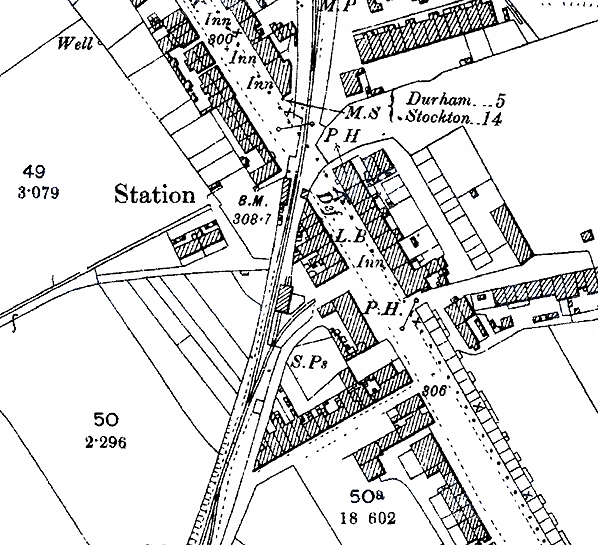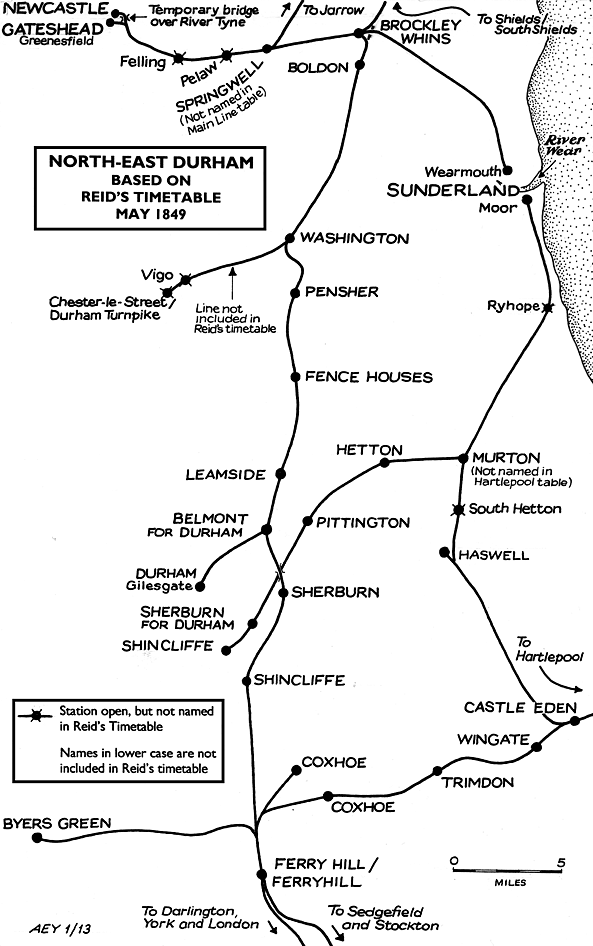
Station Name: COXHOE[Source:
Alan Young]
old1.jpg) In August 1958 the diminutive passenger station at Coxhoe is standing, with both its modest brick building and extremely low and short platform. Passenger trains to Coxhoe ceased in 1902, but the goods facilities are retained behind and to the right of the camera, and the line continues over Station Road level crossing for mineral traffic.
Photo by Ken Hoole 
1897 1:2,500 OS map. In 1897 Coxhoe station had a sparse service of passenger trains to and from Ferryhill, to the south-west. The small station building can be seen to the west of the track, immediately south of Station Road level crossing. A platform is shown rather indistinctly. Two short sidings and a goods shed (not named) are to the south of the station, east of the through track. The line continues beyond the crossing, and at the time of this map served collieries including Crow Trees (Quarrington) and South Kelloe, though at one time a through mineral line provided a connection to Hartlepool. For a short period in the 1830s a passenger service operated beyond (but not calling at) Coxhoe; parliamentary papers refer to it operating to the Clarence Tavern at Crow Trees between 1835 and 1837.

1939 1:2,500 OS map. Coxhoe’s passenger trains were withdrawn in 1902 but the station was retained for goods traffic until 1966. This map published in 1939 does not acknowledge its closure to passengers. The station building and platform remain in place, and the goods shed is named, now without a siding entering it. The line continues beyond the level crossing for mineral traffic.
22.jpg) Looking south-west across the Station Street level crossing c. 1950s. Despite closure to passengers in 1902 the platform building survived into the 1960s. The goods shed can just be made out on the far left,
old12.jpg) Looking south-west across the Station Street level crossing towards Coxhoe station on 23 May 1964 during a visit of SLS 'The South Durham Ltd' brake van tour
Photo by Anthony Davies of the SLS. old4.jpg) The locomotive is seen at Coxhoe immediately north-east of the level crossing and station (off the photo, to the left). At this point a run-round loop begins, and rakes of wagons are standing on the running line and the loop. The loco No. 63397 seen here is a Raven-designed Q6 0-8-0 built at the NER Darlington works in December 1918. Initially carrying the number 2240 the LNER changed it to 3397, BR adding the ‘6’ shortly after Nationalisation. In 1948 its home was 51B, Newport (-on-Tees) shed and in May 1967 it was withdrawn from 51C West Hartlepool shed and cut up by Arnott Young
of Dinsdale the following August Photo from SC Dent collection old3.jpg) Looking north-east towards Station Street level crossing at Coxhoe c1978. The platform is extant but the station building has been demolished.
Photo by Don Wilcock old9.jpg) Looking south-west towards Ferryhill from Coxhoe station in May 1971. The former passenger platform and its stone-built back wall can be seen on the right. The goods facilities, which operated until 1966, were ahead and to the left.
Photo by Alan Brown old10.jpg)
Looking south-west over the Station Road (A177) level crossing at Coxhoe on 9 May 1971. Traditional crossing gates remain in place, and the branch line is retained to serve Coxhoe Quarry. The former passenger station, closed in 1902, was on the right, immediately beyond the crossing, and the goods shed is to the left. The goods facilities closed in October 1966. The Station Hotel was just off
camera to the left,
5.jpg) Looking north at Coxhoe station in October 2013; the goods shed is behind the photographer.
Photo by Ali Ford 3.jpg)
Looking south across the Station Road level crossing towards the site of Coxhoe station
in October 2013. Photo by Ali Ford 15.jpg)
The site of Coxhoe station platform in October 2013. The wall, which stood at the back of the platform can be seen in some of the pictures above. It is likely that the platform is still there under the tarmac. The north end of the platform might just be hidden by vegetation.
Photo by Roy Lambeth 14.jpg) The renovated Coxhoe goods shed in October 2013. The office on the left is new as is an extension to the building at the south end. It is now used as a retail outlet called Savvy Row.
Photo by Roy Lambeth
|


 The May 1849 timetable shows two weekday trains from Coxhoe, departing at 8.40 am and 4.40 pm calling at Ferryhill and Sedgefield en route to Stockton. In the reverse direction trains arrived from Stockton at 8.30 am and 4.35 pm. A Saturday-only market train is shown leaving Coxhoe at 8.45 (instead of the 08.40?) and arriving at 3.30 pm. Over the following quarter-century Ferryhill became a junction of some importance on the East Coast main line, which continued north to Newcastle via Leamside until the present route via Durham was opened in 1872. By that time a further station – Coxhoe Bridge - had opened on the Ferryhill to Hartlepool line to serve the village, but the Coxhoe branch retained its paltry service of passenger trains. In the summer 1896 timetable, two trains still ran each way on weekdays, as seen below; they were hauled by 0-6-0WT No.24.
The May 1849 timetable shows two weekday trains from Coxhoe, departing at 8.40 am and 4.40 pm calling at Ferryhill and Sedgefield en route to Stockton. In the reverse direction trains arrived from Stockton at 8.30 am and 4.35 pm. A Saturday-only market train is shown leaving Coxhoe at 8.45 (instead of the 08.40?) and arriving at 3.30 pm. Over the following quarter-century Ferryhill became a junction of some importance on the East Coast main line, which continued north to Newcastle via Leamside until the present route via Durham was opened in 1872. By that time a further station – Coxhoe Bridge - had opened on the Ferryhill to Hartlepool line to serve the village, but the Coxhoe branch retained its paltry service of passenger trains. In the summer 1896 timetable, two trains still ran each way on weekdays, as seen below; they were hauled by 0-6-0WT No.24.
1.jpg)
7.jpg)
old_thumb11.jpg)
old_thumb5.jpg)
old_thumb6.jpg)
old_thumb7.jpg)
oldthumb8.jpg)
old_thumb2.jpg)
thumb21.jpg)
thumb6.jpg)
thumb2.jpg)
thumb4.jpg)
thumb12.jpg)
thumb13.jpg)
thumb8.jpg)
thumb9.jpg)
thumb10.jpg)
thumb11.jpg)
thumb16.jpg)
thumb17.jpg)
thumb18.jpg)
thumb19.jpg)
thumb20.jpg)

 Home Page
Home Page